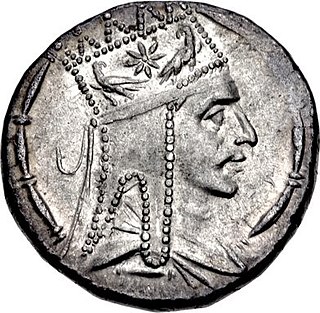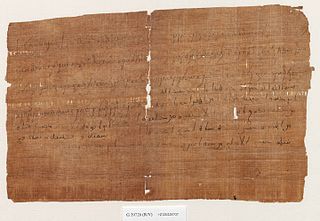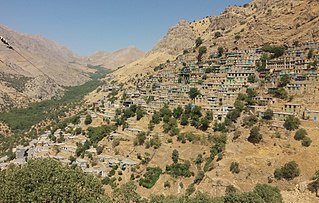Related Research Articles

Nippur was an ancient Sumerian city. It was the special seat of the worship of the Sumerian god Enlil, the "Lord Wind", ruler of the cosmos, subject to An alone. Nippur was located in modern Nuffar 5 miles north of modern Afak, Al-Qādisiyyah Governorate, Iraq. It is roughly 200 kilometers south of modern Baghdad and about 96.56 km southeast of the ancient city of Babylon. Occupation at the site extended back to the Ubaid period, the Uruk period, and the Jemdet Nasr period. The origin of the ancient name is unknown but different proposals have been made.

Tigranes II, more commonly known as Tigranes the Great, was a king of Armenia. A member of the Artaxiad dynasty, he ruled from 95 BC to 55 BC. Under his reign, the Armenian kingdom expanded beyond its traditional boundaries and reached its peak, allowing Tigranes to claim the title Great King or King of Kings. His empire for a short time was the most powerful state to the east of the Roman Republic. Tigranes's title King of Kings is linked, along his victories, also to the appearance of Halley comet during his reign , as depicted on the rare series of Tigranes's coins.

Roxana was a Sogdian or a Bactrian princess who Alexander the Great married after defeating Darius, ruler of the Achaemenid Empire, and invading Persia. The exact date of her birth is unknown, but she was probably in her early teens at the time of her wedding.

Dura-Europos was a Hellenistic, Parthian, and Roman border city built on an escarpment 90 metres above the southwestern bank of the Euphrates river. It is located near the village of Salhiyé, in present-day Syria. Dura-Europos was founded around 300 BC by Seleucus I Nicator, who founded the Seleucid Empire as one of the Diadochi of Alexander the Great. In 113 BC, Parthians conquered the city, and held it, with one brief Roman intermission, until 165 AD. Under Parthian rule, it became an important provincial administrative centre. The Romans decisively captured Dura-Europos in 165 AD and greatly enlarged it as their easternmost stronghold in Mesopotamia, until it was captured by the Sasanian Empire after a siege in 256–57 AD. Its population was deported, and the abandoned city eventually became covered by sand and mud and disappeared from sight.

Nuzi was an ancient Mesopotamian city southwest of the city of Arrapha, located near the Tigris river. The site consists of one medium-sized multiperiod tell and two small single period mounds.

Kuchean was a Western member of the Tocharian branch of Indo-European languages, extinct from the ninth century. Once spoken in the Tarim Basin in Central Asia, Tocharian B shows an internal chronological development; three linguistic stages have been detected. The oldest stage is attested only in Kucha. There is also the middle ('classicalʼ), and the late stage.

PERF 558 is the oldest surviving Arabic papyrus, found in Heracleopolis in Egypt, and is also the oldest dated Arabic text using the Islamic era, dating to 643. It is a bilingual Arabic-Greek fragment, consisting of a tax receipt, or as it puts it "Document concerning the delivery of sheep to the Magarites and other people who arrived, as a down-payment of the taxes of the first indiction."
Barzani Jewish Neo-Aramaic is a modern Jewish Aramaic language, often called Neo-Aramaic or Judeo-Aramaic. It was originally spoken in three villages near Aqrah in Iraqi Kurdistan. The native name of the language is Lishanid Janan, which means 'our language', and is similar to names used by other Jewish Neo-Aramaic dialects .

Amedi or Amadiya is a town in the Duhok Governorate of Kurdistan Region of Iraq. It is built on a mesa in the broader Great Zab river valley.
The Parthian language, also known as Arsacid Pahlavi and Pahlawānīg, is an extinct ancient Northwestern Iranian language once spoken in Parthia, a region situated in present-day northeastern Iran and Turkmenistan. Parthian was the language of state of the Arsacid Parthian Empire, as well as of its eponymous branches of the Arsacid dynasty of Armenia, Arsacid dynasty of Iberia, and the Arsacid dynasty of Caucasian Albania.

Avroman or Hawraman, is a mountainous region located within the provinces of Kurdistan and Kermanshah in western Iran and in north-eastern Kurdistan Region in Iraq. The main part of the Hawraman region is located in Iran and encompasses two components of the Central-Eastern Valley ; and the Western Valley. The mode of human habitation in these two valleys has been adapted over millennia to the rough mountainous environment. Tiered steep-slope planning and architecture, gardening on dry-stone terraces, livestock breeding, and seasonal vertical migration are among the distinctive features of the local culture and life of the Hawrami Kurdish people who dwell in lowlands and highlands during different seasons of each year. On July 27, 2021, part of the Hawraman region along with Uramanat were inscribed on the UNESCO World Heritage List as a cultural site under the name "Cultural Landscape of Hawraman/Uramanat".

Saka, or Sakan, was a variety of Eastern Iranian languages, attested from the ancient Buddhist kingdoms of Khotan, Kashgar and Tumshuq in the Tarim Basin, in what is now southern Xinjiang, China. It is a Middle Iranian language. The two kingdoms differed in dialect, their speech known as Khotanese and Tumshuqese.

Marion was one of the Ten city-kingdoms of Cyprus. It was situated in the north-west of the island in the Akamas region, close to or under the present town of Polis. Both Strabo and Pliny the Elder mention the city in their writings.
Naram-Suen was a king who ruled over Eshnunna for at least nine years during the later 19th century BCE, during its brief time of political power. He is known to be the son of Ipiq-Adad II, king of Eshnunna, and a contemporary of Shamshi-Adad I, king of the Kingdom of Upper Mesopotamia.

Anahita is the Old Persian form of the name of an Iranian goddess and appears in complete and earlier form as Aredvi Sura Anahita, the Avestan name of an Indo-Iranian cosmological figure venerated as the divinity of "the Waters" (Aban) and hence associated with fertility, healing and wisdom. There is also a temple named Anahita in Iran. Aredvi Sura Anahita is Ardwisur Anahid or Nahid (ناهید) in Middle and Modern Persian, and Anahit in Armenian. An iconic shrine cult of Aredvi Sura Anahita was, together with other shrine cults, "introduced apparently in the 4th century BCE and lasted until it was suppressed in the wake of an iconoclastic movement under the Sassanids." The symbol of goddess Anahita is the Lotus flower. Lotus Festival is an Iranian festival that is held on the end of the first week of July. Holding this festival at this time was probably based on the blooming of lotus flowers at the beginning of summer.

Cultural Landscape of Hawraman or Cultural Landscape of Uramanat is the 26th tangible cultural heritage of Iran. This remote and mountainous landscape bears testimony to the traditional culture of the Hawrami people, an agropastoral Kurdish tribe that has inhabited the region since about 3000 BCE. The property, at the heart of the Zagros Mountains in the provinces of Kurdistan and Kermanshah along the western border of Iran.

Darian Dam was constructed on the Sirwan River between 2009 and 2015. The Dam is located in the Hawrāmān region of Kurdistan and Kermanshah. The Darian Dam Archeological Salvage Program (DDASP) was planned by the Iranian Center for Archaeological Research before flooding the reservoir.
Shaykh Mustafa Takhtayi or Shaikh Mostafa Takhti was Kurdish poet from Avroman Takht who lived before 1788. His works are among the earliest samples of written Gorani school of poetry. Takhtî was the father of poet Sheikh Ahmad Takhti who was born in around 1640.

The Salvation Force was a Naqshbandi Sufi Islamist militant group composed of Kurds, active in the Avroman region of Iranian Kurdistan during the 1979–1983 Kurdistan conflict and Iran-Iraq war. Like other Kurdish separatist groups in Iran, they aligned with and were armed by the Iraqi side. For the period of its existence, it was led by its founder Sheikh Muhammad Uthman Siraj al-Din Naqshbandi, of the prominent Sheikhs of Tawilah family.
References
- 1 2 Edmonds, C. J. (1952). "The Place Names of the Avroman Parchments". Bulletin of the School of Oriental and African Studies. 14 (3): 478–82. doi:10.1017/S0041977X00088455. ISSN 0041-977X.
- ↑ Nyberg, H. S. (1923). "The Pahlavi documents of Avroman". Le Monde Oriental. 17: 182–230.
- ↑ Ellis H. Minns (1915). "Parchments of the Parthian Period from Avroman in Kurdistan". Journal of Hellenic Studies. 35: 98–141. doi:10.2307/624522. JSTOR 624522.
- ↑ Sayce, A. H. (1919). "Two Notes on Hellenic Asia I, The Aramaic Parchment from Avroman". Journal of Hellenic Studies. 39: 182–230. doi:10.2307/624881. JSTOR 624881.